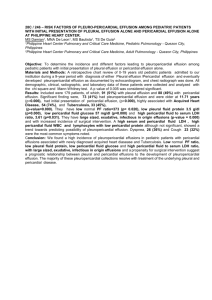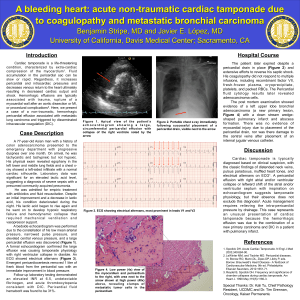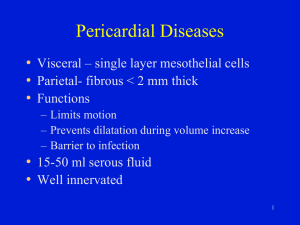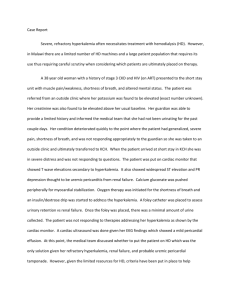Document 14240212
advertisement
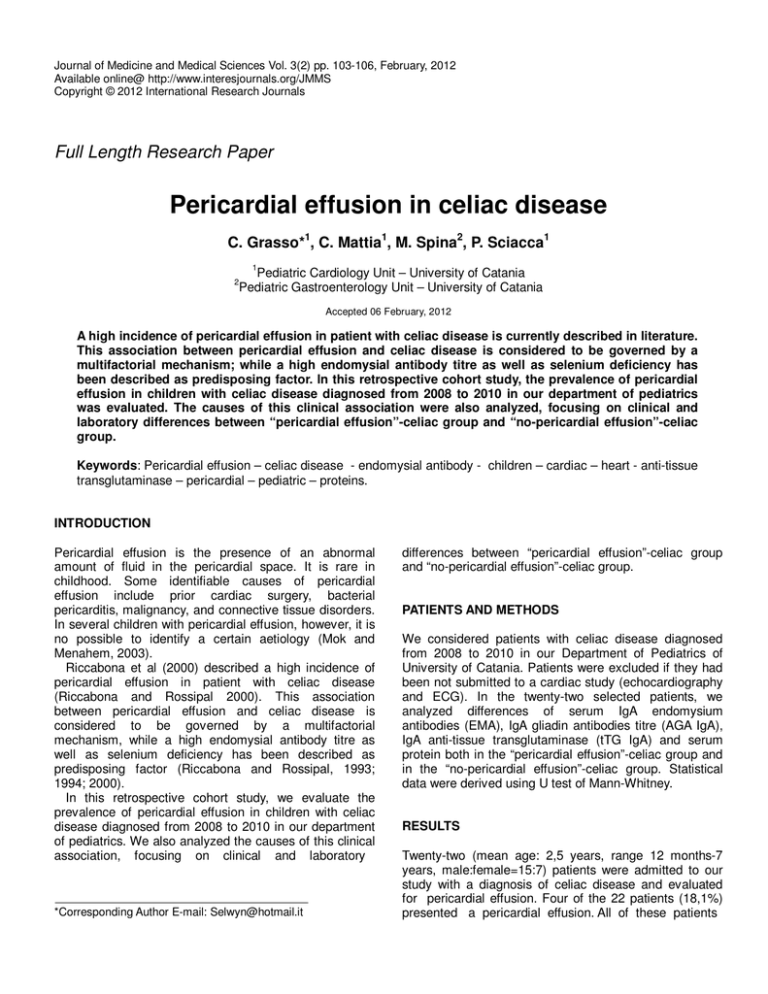
Journal of Medicine and Medical Sciences Vol. 3(2) pp. 103-106, February, 2012 Available online@ http://www.interesjournals.org/JMMS Copyright © 2012 International Research Journals Full Length Research Paper Pericardial effusion in celiac disease C. Grasso*1, C. Mattia1, M. Spina2, P. Sciacca1 1 Pediatric Cardiology Unit – University of Catania Pediatric Gastroenterology Unit – University of Catania 2 Accepted 06 February, 2012 A high incidence of pericardial effusion in patient with celiac disease is currently described in literature. This association between pericardial effusion and celiac disease is considered to be governed by a multifactorial mechanism; while a high endomysial antibody titre as well as selenium deficiency has been described as predisposing factor. In this retrospective cohort study, the prevalence of pericardial effusion in children with celiac disease diagnosed from 2008 to 2010 in our department of pediatrics was evaluated. The causes of this clinical association were also analyzed, focusing on clinical and laboratory differences between “pericardial effusion”-celiac group and “no-pericardial effusion”-celiac group. Keywords: Pericardial effusion – celiac disease - endomysial antibody - children – cardiac – heart - anti-tissue transglutaminase – pericardial – pediatric – proteins. INTRODUCTION Pericardial effusion is the presence of an abnormal amount of fluid in the pericardial space. It is rare in childhood. Some identifiable causes of pericardial effusion include prior cardiac surgery, bacterial pericarditis, malignancy, and connective tissue disorders. In several children with pericardial effusion, however, it is no possible to identify a certain aetiology (Mok and Menahem, 2003). Riccabona et al (2000) described a high incidence of pericardial effusion in patient with celiac disease (Riccabona and Rossipal 2000). This association between pericardial effusion and celiac disease is considered to be governed by a multifactorial mechanism, while a high endomysial antibody titre as well as selenium deficiency has been described as predisposing factor (Riccabona and Rossipal, 1993; 1994; 2000). In this retrospective cohort study, we evaluate the prevalence of pericardial effusion in children with celiac disease diagnosed from 2008 to 2010 in our department of pediatrics. We also analyzed the causes of this clinical association, focusing on clinical and laboratory *Corresponding Author E-mail: Selwyn@hotmail.it differences between “pericardial effusion”-celiac group and “no-pericardial effusion”-celiac group. PATIENTS AND METHODS We considered patients with celiac disease diagnosed from 2008 to 2010 in our Department of Pediatrics of University of Catania. Patients were excluded if they had been not submitted to a cardiac study (echocardiography and ECG). In the twenty-two selected patients, we analyzed differences of serum IgA endomysium antibodies (EMA), IgA gliadin antibodies titre (AGA IgA), IgA anti-tissue transglutaminase (tTG IgA) and serum protein both in the “pericardial effusion”-celiac group and in the “no-pericardial effusion”-celiac group. Statistical data were derived using U test of Mann-Whitney. RESULTS Twenty-two (mean age: 2,5 years, range 12 months-7 years, male:female=15:7) patients were admitted to our study with a diagnosis of celiac disease and evaluated for pericardial effusion. Four of the 22 patients (18,1%) presented a pericardial effusion. All of these patients 104 J. Med. Med. Sci. Figure 1. Mean values of IgA gliadin antibodies (AGA IgA) and IgA anti-tissue transglutaminase antibodies (tTG IgA) in patients without pericardial effusion (no p.e.) and in those with pericardial effusion (p.e.) P<0,05 Figure 2. Mean values of serum proteins in patients without pericardial effusion (no p.e.) and in those with pericardial effusion (p.e.). were females under the age of two years. Three patients presented non-specific repolarization disorders at ECG. Patients with pericardial effusion were different from patients with electrocardiographic disorders as shown in figure 1 and 2. All patients had normal serum level of IgA. In our experience there were not statistically significant differences (p>0,05) between the two groups concerning endomysial antibody titre, IgA gliadin antibodies titre (“pericardial effusion-celiac group”:mean: 333,33 U/ml; max 350 U/ml; min 300 U/ml VS “no-pericardial effusionceliac group”: mean: 190,25 U/ml; max 350 U/ml; min 6 U/ml), IgA and anti-tissue transglutaminase (“pericardial effusion-celiac group”: mean: 350 U/ml max: 350 U/ml; min: 350 U/ml VS “no-pericardial effusion-celiac group”: mean: 268,93 U/ml; max: 350 U/ml; min: 54 U/ml). There were statistically significant differences (p<0,05) between the two groups relative to serum proteins level (“pericardial effusion-celiac” group mean: 5,3 g/dl; max 5,7 g/dl; min 5,3 g/dl VS “no-pericardial effusion”-celiac group” mean: 6,1 g/dl; max 6,8 g/dl; min 6,0 g/dl) (Table 1, Table 2) In all patients the pericardial effusion resolved after gluten-free diet (GFD). Grasso et al. 105 Table 1. Sex, age, IgA gliadin antibodies (AGA IgA), IgA anti-tissue transglutaminase antibodies (tTG IgA), Ig A anti endomysium antibodies (EMA) and proteins values in celiac patients without pericardial effusion PATIENT A.E. B.C. C.M. M.M. M.M. S.P. S.G. Z.G. C.G. C.A. L.M.C. M.A. T.S. B.L. I.C. R.A. R.E. S.S. AGE (years) 1 3 3 2 1 3 7 2 3 3 1 2 1 2 5 1 1 5 GENDER M M F F F M M F M F F F F M F F M F AGA (U/ml) 350 22 350 216 15 350 37,4 180 350 6 11 280 350 303 300 111 103 90,4 EMA +++ +++ +++ +++ +++ +++ +++ +++ +++ +++ +++ ++ +++ +++ +++ +++ +++ +++ tTG (U/ml) 350 350 350 300 350 310 350 350 300 54 161 132 350 350 188 139,3 156,4 300 PROTEINS (g/dl) 6 5,1 6,4 6,9 5,4 6,2 5,2 6,5 6 6,8 6,2 6,8 5,9 6 6,3 6,4 6,3 6 Table 2. Sex, age, IgA gliadin antibodies (AGA IgA), IgA anti-tissue transglutaminase antibodies (tTG IgA), Ig A anti endomysium antibodies (EMA) and proteins values in celiac patients with pericardial effusion. PATIENT C.Z. G.G. G.A. R.C. AGE (years) 1 1 2 2 GENDER F F F F AGA (U/ml) 300 330 350 350 DISCUSSION Pericardial effusion is a rare disease in childhood [5]. In our experience, in four years, have been identified only 45 patients with pericardial effusion due to non oncohematological causes, out of 13.950 echocardiography performed. Some identifiable causes of pericardial effusion are prior cardiac surgery, bacterial pericarditis, malignancy, and connective tissue disorders. In several children with pericardial effusion, however, it is not possible to identify a certain aetiology (Mok and Menahem, 2003). In 1975, Scott et al already described the pericardial involvement in celiac disease (Scott and Losowsky, 1975). We identified 4 celiac patients out of 45 with pericardial effusion from 2008 to 2010. It has been suggested that the deposition of immune complexes originating from the small-bowel in other organs, could be a possible reason, in some patients, for the described association between celiac disease and EMA +++ +++ +++ +++ tTG (U/ml) 350 350 350 350 PROTEINS (g/dl) 5,7 5,5 5,3 5,6 a range of "autoimmune" diseases (Scott and Losowsky, 1975). Pericardial effusion is, probably, a result of these autoimmune disorders related to celiac disease. In untreated celiac patients there are signs of activation of both mucosal cellular and humoral immune systems (Sollid et al., 1997; Tredjosiewics and Howdle, 1995). The coexistence of this disease and others autoimmune disorders could be explained by molecular mimicry by which gliadin or tissue transglutaminase activates T cells that are cross-reactive with various self-antigens (Collin et al., 2002). Schuppan (2000) in his study supposed that tissue tranglutaminase can modify others external or selfantigens by cross-linking or deamidation and thus generate different neoantigens. The production of antigens and antibodies can provoke various autoimmune phenomena outside the intestine (Schuppan, 2000). Chronic inflammation and oxidative stress may also lead to an aberrant activation of transglutaminases in 106 J. Med. Med. Sci. different tissues. Transglutaminases abnormally activated can cause cytotoxic damage and, consequently, contribute to different patterns of disease (Kim et al., 2002). Moreover the increased intestinal permeability in celiac disease due to chronic inflammation and increased production of molecules like zonulin can facilitate the development of others autoimmune disorders including those that would be the cause of pericardial effusion (Fasano et al., 2000; Fasano A, 2001). In celiac disease, in fact, external antigens such as food proteins, bacterial products, and endotoxins are easier to overcome the intestinal lamina propria and, consequently, to cause the activation of autoimmune phenomena (Fasano A, 2001). Riccabona et al (1993, 2000) described association between celiac disease and pericardial effusion (Riccabona and Rossipal, 1993; 1994). They observed that the patients with pericardial fluid were older (range: 7-36 months) than those without effusion, and that the majority of patients with pericardial effusion were diagnosed during the cold season, reporting symptoms of previous viral infection without virological evidence for a specific viral infection (Riccabona and Rossipal, 1994; 2000). In our experience patients with pericardial fluid, were aged between 12 and 24 months. Diagnoses were made in different times of year, without the prevalence of a particular season and without classic signs of previous viral infection. Riccabona et al. (2000) didn't found correlation with nutritional status and found normal serum protein level, therefore stated that hypoproteinaemia was not responsible for pericardial effusion (Riccabona and Rossipal, 1994). In all our patients with pericardial effusion we found low serum protein level (mean:5,3). This levels were significantly lower (p=0,04) than those of celiac patients without pericardial effusion. We can suppose that, especially in younger infant below 24 months of age, lower levels of proteins can play a partial role in determining pericardial effusion by facilitating fluid trasudation due to reduction of the protein related oncotic pressure, obviously in the presence of an immunologic mediated damage , as postulated by Riccabona et al (2000) (Riccabona and Rossipal, 1994) About this are surely required further studies with many more patients. In our patients, we didn’t find the presence of higher values of EMA in patients with pericardial fluid as previously described (Riccabona and Rossipal 2000; Schuppan, 2000), we found high levels of serum IgA endomysium antibodies (EMA), IgA gliadin antibodies titre (IgA AGA), IgA anti-tissue transglutaminase (IgA tTG) in patients with pericardial effusion but these levels weren’t higher than those of the control group. The role of celiac disease in pathogenesis of heart disease is not clear. Though we can conclude that association between pericardial effusion and celiac disease is governed by a multifactorial mechanism (Riccabona and Rossipal 2000). We suggest that might be interesting further investigate heart /celiac disease relation by including the study of cardiac function as part of tests to perform in all case of newly diagnosed celiac disease, especially in younger children. Moreover, pediatric cardiologist could start to include serological assay for the diagnosis of celiac disease in the tests to be taken in case of incidental findings of pericardial effusion or some other acquired cardiac pathologies. REFERENCE Collin P, Kaukinen K, Välimäki M, Salmi J (2002). Endocrinological Disorders and Celiac Disease. Endocr Rev. 23(4):464-483. Fasano A, Not T, Wang W, Uzzau S, Berti I, Tommasini A, Glodblum SE (2000). Zonulin, a newly discovered modulator of intestinal permeability, and its expression in coeliac disease. Lancet. 355:15181519. Fasano A (2001). Intestinal zonulin: open seasame! Gut. 49:159-162. Kim S-Y, Jeitner TM, Steinert PM (2002). Transglutaminases in disease. Neurochem Int. 20:83-103. Mok GC, Menahem S (2003). Large pericardial effusion of inflammatory origin in childhood. Cardiol Young. 13(2):131-136 Riccabona M, Rossipal E (1993). Sonographic findings in celiac disease. J. Pediatr Gastroenterol Nutr. 17(2):198-200. Riccabona M, Rossipal E (1994). Do endomysial antibodies in connection with selenium deficiency contribute to pericardial effusions in coeliac disease? Eur. J. Pediatr.153(11):865. Riccabona M, Rossipal E (2000). Pericardial effusion in celiac disease – an incidental finding? Wien Klin Wochenschr. 112(1):27-31 Schuppan D (2000). Current concepts of celiac disease pathogenesis. Gastoenterology. 119:234-242. Scott BB, Losowsky MS (1975). Coeliac disease: a cause of various associated diseases? Lancet. 15;2(7942):956-957. Sollid LM, Molberg O, McAdam S, Lundin KEA (1997). Autoantibodies in coeliac disease: tissue transglutaminase – guilt by association. Gut. 41:851-852 Tredjosiewics LK, Howdle PD (1995). T-cell responses and cellular immunity in coeliac disease. Baillieres Clin Gastroenterol. 9:251-272.
